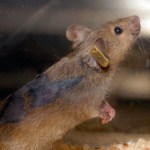gene
Water bears, aka tardigrades, are resilient little creatures. These microscopic animals can survive both freezing and boiling temperatures, radiation, high pressure, starvation, the vacuum of space and even desiccation. This last ability caught the attention of a team of researchers interested in how they are able to survive for years despite being completely dried out, an ability known as anhydrobiosis.
Video by Daiki D. Horikawa, via YouTube.
The team discovered special genes that make proteins to protect the animal's cells during anhydrobiosis. The proteins created by…
Dummerstorf marathon mouse, Image from Leibniz Institute for Farm Animal Biology
As the name implies, Dummerstorf marathon mice are bred to run. If allowed to be sedentary, these animals can build up quite a bit of fat within their peripheral tissues even if they do not overeat. If given an exercise wheel, however, they burn fat very quickly.
In a new study published in the Journal of Comparative Physiology - B, researchers discovered that the livers of these mice have an increased ability to not only store fat but to also rapidly mobilize fat when necessary…
Tasmanian devils are rather large carnivorous marsupials. By large, I mean the world's largest.
In only 2 decades, the population of Tasmanian devils have declined by about 85%, landing these animals on the endangered species list. The cause: an infectious cancer called devil facial tumor disease (DFTD). As the name implies, this cancer causes facial tumors that grow so large, the victims starve to death in as little as 6 months from an inability to eat. What makes this cancer particularly devastating to a population is how it spreads between animals through bites and the one thing…
I came across this neat press release from the American Physiological Society which describes new research on understanding how the genes of burmese pythons are actually altered by feeding. Fascinating! The research was published in the May issue of Physiological Genomics. Here is a brief synopsis. For the full story, visit the APS website.
Yep, that's a python eating a rodent.
What is so fascinating about Burmese pythons is that their body literally is reconstructed within 3 days of eating resulting in the doubling or organ size and a 10-44 fold increase in…
Scientists have identified the origin of a genome for a specific type of transmissible cancer that has spread between dogs beginning 11,000 years ago!
Image of common model organisms from European Molecular Biology Laboratory (EMBL).
A recent article posted in the BBC News provided a good explanation of why scientists commonly study these organisms as models for human diseases and conditions. Model organisms are chosen because their physiology is similar to other animals, including humans, in addition to other reasons:
Visit the BBC News to see why researchers most often use flies, fish, mice and worms to understand the mechanisms of disease and health.
Did you know that ~70% of the genes in a…
Find out why most species of birds do not have a penis in this video abstract of new research published yesterday in Current Biology:
Source
Herrera AM, Shuster SG, Perriton CL, Cohn MJ. Developmental basis of phallus reduction during bird evolution. Current Biology Published online June 6, 2013. doi: 10.1016/j.cub.2013.04.062
Image of atopic dermatitis from www.itchfreepet.com
Dr. Kerstin Lindblad-Toh at Uppsala University (Sweden) who specializes in comparative genomics and Dr. Åke Hedhammar, SLU (Sweden) recently identified a novel gene in German shepherd dogs, PKP-2, that encodes a protein (plakophilin-2) important for regulating proper skin structure and function. This protein was found to be associated with canine atopic dermatitis (i.e. doggy eczema), a condition that affects 3-10% of man's best friends. Researchers hope that the discovery of this gene relationship may lead to better understanding of…
You may recall a prior blog entry about a new experimental treatment for bone cancer in dogs. Researchers are increasingly studying canine cancer and discovering that it is caused by some of the same genetic mutations that cause cancer in humans.
Shown in the image above is Jasper, a 7-year old dog that has lymphoma, cancer of the immune system (white blood cells) that is similar to non-Hodgkin lymphoma that afflicts people. Researchers are hoping that studying the DNA of dogs with cancer may lead to treatments for not only dogs, but also people. The…
Image by He Meng, from Nature News
Bactrian camels thrive in conditions considered harsh by many standards: very dry, cold, high elevations. Researchers now suspect their physiological adaptations of high blood sugar, high salt diets, and increased body fat may have evolved to help the animals cope with their environment. For humans, those symptoms could lead to heart disease, but for the Bactrian camel, they are considered physiological, i.e. totally normal.
A paper published in Nature Communications describes the genomic variations in wild and domesticated Bactrian camels. What they…
When you look over the assortment of sizes, shapes and colors of tomatoes displayed in the market, do you stop to consider the time and effort that went into developing them (more than ten years to create a new commercial cultivar)? But a variety of sweet, pink-skinned tomato that's popular in the Far East could speed-up the breeding of new cultivars in this region. In the search for the mutation that gives these tomatoes their pink hue, Weizmann scientists discovered a "master" gene that regulates the levels of hundreds of tomato metabolites. That gene, say the scientists, might be used as a…
Millions of years before humans invented sonar, bats and toothed whales had mastered the biological version of the same trick - echolocation. By timing the echoes of their calls, one group effortlessly flies through the darkest of skies and the other swims through the murkiest of waters. It's amazing enough that two such different groups of mammals should have evolved the same trick but that similarity isn't just skin deep.
The echolocation abilities of bats and whales, though different in their details, rely on the same changes to the same gene - Prestin. These changes have produced such…
In the White Sands National Park of New Mexico, there are three species of small lizard that all share white complexions. In the dark soil of the surrounding landscapes, all three lizards wear coloured coats with an array of hues, stripes and spots. Colours would make them stand out like a beacon among the white sands so natural selection has bleached their skins. Within the last few thousand years, the lesser earless lizard, the eastern fence lizard and the little striped whiptail have all evolved white forms that camouflage beautifully among the white dunes.
Erica Bree Rosenblum…
In science, we don't often get to talk about male repression, but a new discovery gives us just such a chance. It turns out that ovaries can only remain ovaries by constantly suppressing their ability to become male. Silence a single gene, and adult ovaries turn into testes. That adult tissues can be transformed in this way would be surprising enough, but doing so by changing a single gene is truly astonishing.
As embryos, our gonads aren't specific to either gender. Their default course is a female one, but they can be diverted through the action of a gene called SRY that sits on the Y…
Today, a new paper published in Nature adds another chapter to the story of FOXP2, a gene with important roles in speech and language. The FOXP2 story is a fascinating tale that I covered in New Scientist last year. It's one of the pieces I'm proudest of so I'm reprinting it here with kind permission from Roger Highfield, and with edits incorporating new discoveries since the time of writing.
The FOXP2 Story (2009 edition)
Imagine an orchestra full of eager musicians which, thanks to an incompetent conductor, produces nothing more than an unrelieved cacophony. You're starting to…
You might think the coolest thing about the Next Generation DNA Sequencing technologies is that we can use them to sequence long-dead mammoths, entire populations of microbes, or bits of bone from Neanderthals.
But you would be wrong.
Sure, those are all cool things to do, but Next Generation DNA sequencing (or NGS for short) can give us answers to questions that are far, far more interesting.
With NGS, we can look at entire transcriptomes (!!) together with the proteins that make them and the DNA modifications that help regulate them. If we compare a cell to music, a genome sequence…
When Walt Disney created Mickey Mouse in 1928, he understood the draw that anthropomorphic mice would have. But even Walt's imagination might have struggled to foresee the events that have just taken place in a German genetics laboratory. There, a group of scientists led by Wolfgang Enard have "humanising" a gene in mice to study its potential relevance for human evolution.
The gene in question is the fascinating FOXP2, which I have written extensively about before, particularly in a feature for New Scientist. FOXP2 was initially identified as the gene behind an inherited disorder that…
The success of termites Âand other social insects hinges on their complex social systems, where workers sacrifice the ability to raise their own young in order to serve the colony and its queen - the only individual who reproduces. But this social order can be thrown into chaos by knocking out a single gene, and one that originally had a role in that other characteristic termite ability - eating wood.
Judith Korb from the University of Osnabrueck in Germany found that the queen termite relies on a gene called Neofem2 to rule over her subjects. Korb worked with the termite Cryptotermes…
The world of genetics is filled with stories that are as gripping as the plot of any thriller. Take the IRGM gene - its saga, played out over millions of years, has all the makings of a classic drama. Act One: setting the scene. By duplicating and diverging, this gene thrived in the cells of most mammals as a trinity of related versions that played vital roles in the immune system.
Act Two: tragedy strikes. About 50 million years ago, in the ancestors of today's apes and monkeys, the entire IRGM cluster was practically deleted, leaving behind a sole survivor. Things took a turn for the worse…
Let's play anomaly!
Most of this week, I've written about the fun time I had playing around with NCBI's Blink database and finding evidence that at least one mosquito, Aedes aegypti, seems to have been infected at some point with a plant paramyxovirus and that the paramyxovirus left one of its genes behind, stuck in the mosquito genome.
During this process, I realized that the method I used works with other viruses, too. I tried it with a few random viruses and sure enough, I found some interesting things.
You've got a week to give it a try. Let's see what you find! The method is…



